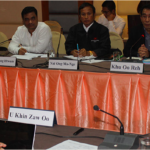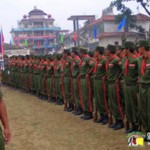Legal Aid Network | July 12, 2018
(1) His speech, in regard to history, is ideologically incorrect. References are incomplete too. His saying as “We should not become prisoners of history” is a mere ignorance of the history. It also means that we shall not be tied up with the history. It is untrue. The concept that should be adopted is, out of the historical events, true factors shall be observed, valued, recognized and, continued to be preserved, while taking lessons from mistakes and attempting to avoid similar erroneous practices in the future.
He just invoked only the events in the era of British Colonial days. He did not mention at all about the distinguished independent histories of other non-Myanmar ethnic nationalities: such as the existence of independent Kingdoms of Shan, Mon, and Rakhine (Arakan); the era of Shan Kings who conquered the Myanmar Kingdoms;1 the prolonged wars between the Mon Kings and Myanmar Kings; Hanthawaddy Army of Mon King occupied Inwa (Ava) of Myanmar King on March 9, 1752.
It is an undeniable fact that Karen, Kachin and Chin areas were independently governed by their own respective rulers. It is evidently recorded in many historical books that Kachin andChin vigorously defended their territories from invasion and annexation of the British.
Before BC 2000, Mon, Ta’ang and Wa lived in central Yunnan once and they had been attacked so often by powerful Mongol-Tatars Chinese Army. Therefore, they migrated into and settled down in Yawnaka Region (aka) Dali-Fu Region, east of upper Mekong River around BC 2000. They have established Kyay (aka) Kawthami Kingdom and elected the Kings since then.
Min Aung Hlaing also did not mention at all about the Karenni State which existed as a sovereign independent state throughout its history and had never been under the Myanmar Kings nor British colonial rule in history.
Kinwun Mingyi U Kaung, Chief Minister, on behalf of Burmese King Mindon and Sir Douglas Forsyth,5 representative of the British Government from India, made an agreement on June 21, 1875 even before British occupied the upper Burma in 1885. In that agreement, it mentioned as below:
British Government and Myanmar King’s Government agreed that Western Karenni Territory shall exist as an independent state and any sovereign power or administrative power shall not be demanded nor shall be exercised upon the Karenni State.
The Karenni Territory, differently from the Shan Territories, has never been under any part of British India. However, it enjoyed an equal status like Indian Princely States.British did not annex the Karenni Territory, instead left it as an independent state.
(2) In his speech, he stated as saying, “In accord with the theory of ‘cause’ and ‘effect’, we must seek and criticize ‘causes’ correctly.” However, unfortunately, diverting from the said commitment, his criticisms were incorrect. What are the causes? He revealed no specific factors. The pivotal causes of civil war in Burma, among others, are as below:
1. No recognition was made by chauvinistic Myanmar military leaders and politicians that the ethnic nationalities and their territories are independently preexisted along the history. None of their rights, reflected their independent histories, were incorporated in any law, nor any protection was provided accordingly.
2. The Communist Party of Burma (CPB) was not allowed to exist as a political party and was forcefully outlawed albeit multi-party democracy was exercised under the 1947Constitution.
3. Legality of the Panglong Agreement under national laws as well as international law has been denied by the Myanmar military leaders and majority of the Myanmar politicians. As of now, full right of self-autonomy has not yet been granted to the Ethnic States.
4. Land, natural resources and environment owned by the ethnic States have been exploited by the Myanmar governments (especially successive Myanmar military leaders) at their discretion since its independence.5. Since the military coup d’etat led by Myanmar Army Gen. Ne Win in March 2, 1962, all ethnic nationalities have been repressed and human rights violations have remained unabated.
Consequently, the ruling regime has started to encounter potential international actions.
(3) “There exist no big or small problems between the Tatmadaw and the armed groups but discontents and demands have surfaced between the respective governments and the armed organizations.” said Min Aung Hlaing in his speech. It’s also a blatant pack of lies. He is trying to avoid the responsibility of Myanmar Army in the history of civil war in Burma. He cornered the NLD government by saying apparently that Myanmar Army is getting along with the ethnic armed organizations and, as such, the incumbent NLD Government is responsible for all underlying issues.
During the struggle of independence, a serious incident happened at the Irrawaddy Division when the British withdrew from Burma and Japanese Army invaded the country. The Burma Independence Army (BIA) under the command of Colonel Mogyo, (Col. Keiji Suzuki, Imperial Japanese Army) massacred a number of the Karen national revolutionaries, led by Shwe Tun Kyar who received arms and ammunitions from the British and fought against the Japanese then.9 It was a heinous crime which is not relevant to the responsibility of the government.
Myanmar Army also committed a number of human rights abuses against Shan people during the time of offensives against the Nationalist Chinese (Kuomintang, or KMT) in Shan State. Therefore, Shan armed resistance groups came into emerge. After military coup in 1962, the military murdered a hundred students from Rangoon University on July 7 and many students joined the Communist Party of Burma and other ethnic armed resistant organizations. The students and youths established the All Burma Students’ Democratic Front (ABSDF) after over 3,000innocent people were killed by Myanmar Army during the 8888 democratic uprising in 1988. All ethnic nationalities established their respective armed groups and launched the armed struggles against the Myanmar Army because the latter committed war crimes, crimes against humanity and genocide in the ethnic States respectively.
The most hideous and atrocious war crime committed by Myanmar Army throughout the history of seeking cease-fire agreements since SLORC military regime was Mongkoe massacre. Kokang group which was the first renegade group diverged from the Communist Party of Burma on March 12, 1989 and became the first group – known as the Myanmar National Democratic Alliance Army – MNDAA who reached to a ceasefire agreement with the SLORC military regime. That group suffered the first and most brutality.
The group controlled areas runs from Laukkai, Chin Shwe Haw to Mongko and the military regime recognized as Shan State Special Region (1). There was a dispute between ‘Pheung’ (Pheung) clan led by Peng Jia Sheng, Peng Jiafu, Peng Tashin and ‘Yan’ one led by Yan Monglian, Yan Mong-ang, Yan Jian Wai, Yan Jian Ci in 1995 in which ‘Pheung’ clan gained upper hand. But, both sides had to accept the deployment of Myanmar Army which entered the territory to side with ‘Pheung’. Myanmar Army involved in adjudication when Lenin Mint tried to take over after purging Mong Sarla, the leader of Mongko. It slaughtered about 150 people, including Lenin Mint, on the spot in Hay Monglon area and buried the corpses in the mass graves. The locals and Chinese ancestors in the area labelled it as the“Second Nanking Massacre”.
Observing such above precedents, it is concerned that the Ethnic Armed Revolutionary Organizations and their people may assume Min Aung Hlaing’s saying of “no big or small problems between Myanmar Army and EAOs” as the “sky full of lies.”
(4) “Our army personnel who have to fight in battlefields unavoidably are the ones who want peace most” continued Min Aung Hlaing in his speech. What does the term ‘Peace’, elaborated by Min Aung Hlaing, mean? He never portrayed it clearly. But, referencing his how-dare-you speech, his meaning of peace evidently indicates that all EAOs lay down arms, set up the political parties, run for elections under the 2008 constitution, and facilitate prolonging of military dictatorship. This path will never lead to a genuine peace.
Peace, envisaged to seek, should be the prevailing of stable, tranquil and peaceful situation with the underpinning that the individual rights of all citizens and the collective rights of all ethnic states and nationalities are prescribed and protected under a “new” Federal Democratic Constitution along the respective (Province) State Constitutions; accordingly, the existence of the independent, impartial and efficient State Organs and State Institutions be guaranteed; and, if the above mentioned rights are infringed in one way oranother, legal actions against the perpetrators – who committed repressions, breaches and violence – are taken by these institutions in order to seek justice and to compensate for the injuries of the victims on the basis of the Rule of Law.
The obstinate path that “all EAOs must surrender”, firmly clutched by Commander-in- Chief Min Aung Hlaing and successive military leaders will never be successful. There will definitely be the armed resistance as long as there are the armed oppressions. Min Aung Hlaing should learn from the historical experience of the Palaung State Liberation Organization (PSLO) and Ta’ang National Liberation Army (TNLA).
PSLO reached a ceasefire agreement on May 1, 1991 with the military regime led by then Gen. Khin Nyunt. It was just a “Gentlemen Agreement” without having an official written accord. Later, PSLO had to lay down arms due to various pressures imposed by the Myanmar military leaders through Major General Myint Hlaing, the then commander of northeastern command. The surrender ceremony was held in Mong Tong town on April 29, 2005.
In that ceremony, on behalf of SPDC military regime, then Prime Minister General Thein Sein, Northeastern Command Commander Major General Myint Hlaing, Central Command Commander Major General Ye Myint, Information Minister Major General Kyaw San, Agricultural & Irrigation Minister Major General Htay Oo, Livestock and Fisheries Minister Major General Maung Maung Thein, and Railway and Transportation Major General Aung Min were present.
On that day of surrender ceremony, Prime Minister General Thein Sein publicly stated by saying, “You do not need to worry at all. In my capacity as a Prime Minister, I promise that theState will not only bring development of your area more than this, but also take full responsibility for your individual security.”
However, the situation of Ta’ang (Palaung) people and their area had been deteriorating, contrary to General Thein Sein’s hollow promise. They suffered from various types of oppression and human rights abuses committed by Myanmar Army and also faced socio-economic hardships. Therefore, the Ta’ang National Liberation Army (TNLA) was established on October 13, 2009 and has been combatting the Myanmar Army. Now, the fighting power of the TNLA has reached ten times greater than when the PSLO laid down their arms.
Only when the Myanmar Army – which invaded, occupied and has oppressively governed the ethnic states without granting their right to self-determination and full autonomy – withdraw from the territories of the Ethnic States, peace seeking process will be expedited and peace will be achieved sooner.
This is only part of the statement. Download the full statement (PDF) in English.







